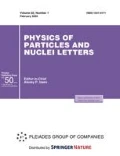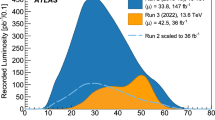Abstract
One of the most important studies dedicated to be solved for ATLAS physical analysis is a reconstruction of proton-proton events with large number of interactions in Transition Radiation Tracker. Paper includes Transition Radiation Tracker performance results obtained with the usage of the ATLAS GRID and Kurchatov Institute’s Data Processing Center including Tier-1 grid site and supercomputer as well as analysis of CPU efficiency during these studies.
Similar content being viewed by others
References
O. S. Brüning, P. Collier, P. Lebrun, S. Myers, R. Ostojic, J. Poole, and P. Proudlock, LHC Design Report CERN-2004-003-V-1 (CERN, Geneva, 2004). https://cds.cern.ch/record/782076.
ATLAS Collab., “The ATLAS experiment at the CERN Large Hadron Collider,” J. Instrum. 3, S08003 (2008).
E. Abat et al., “The ATLAS TRT barrel detector,” J. Instrum. 3, P02014 (2008).
E. Abat et al., “The ATLAS TRT end-cap detectors,” J. Instrum. 3, P10003 (2008).
E. Abat et al., “The ATLAS Transition Radiation Tracker (TRT) proportional drift tube: design and performance,” J. Instrum. 3, P02013 (2008).
WLCG Worldwide LHC Computing Grid. http://lcg.web.cern.ch.
A. I. Alichanian et al., “Transition radiation registration by means of a drift chamber with space resolution 20 µm,” Nucl. Instrum. Methods Phys. Res. 158, 137–143 (1979).
M. Deutschmann and B. Dolgoshein, “The particle identification using the angular distribution of the Transition Radiation,” Preprint CERN EP/8-155 (CERN, 1980).
B. Dolgoshein, “Transition radiation detectors and particle identification,” Nucl. Instrum. Methods Phys. Res., Sect. A 252, 137–144 (1986).
E. Abat et al., “The ATLAS TRT electronics,” J. Instrum. 3, P06007 (2008). http://stacks.iop.org/1748-0221/3/i=06/a=P06007.
ATLAS Collab., “Performance of particle identification with the ATLAS transition radiation tracker,” in Proceedings of the Meeting of the Division of Particles and Fields of American Physical Society DPF-2011, Providence, RI, August 8–13, 2011.
G. Barrand et al., “Gaudi - a software architecture and framework for building HEP data processing applications,” in Proceedings of the International Conference on Computing in High Energy Physics CHEP 2000.
The ATLAS Collab., “Basic ATLAS TRT performance studies of Run 1,” ATL-INDET-PUB-2014-001 (2014).
Author information
Authors and Affiliations
Consortia
Corresponding author
Additional information
The article is published in the original.
Rights and permissions
About this article
Cite this article
Krasnopevtsev, D.V., Klimentov, A.A., Mashinistov, R.Y. et al. Study of ATLAS TRT performance with GRID and supercomputers. Phys. Part. Nuclei Lett. 13, 659–664 (2016). https://doi.org/10.1134/S1547477116050307
Received:
Published:
Issue Date:
DOI: https://doi.org/10.1134/S1547477116050307




